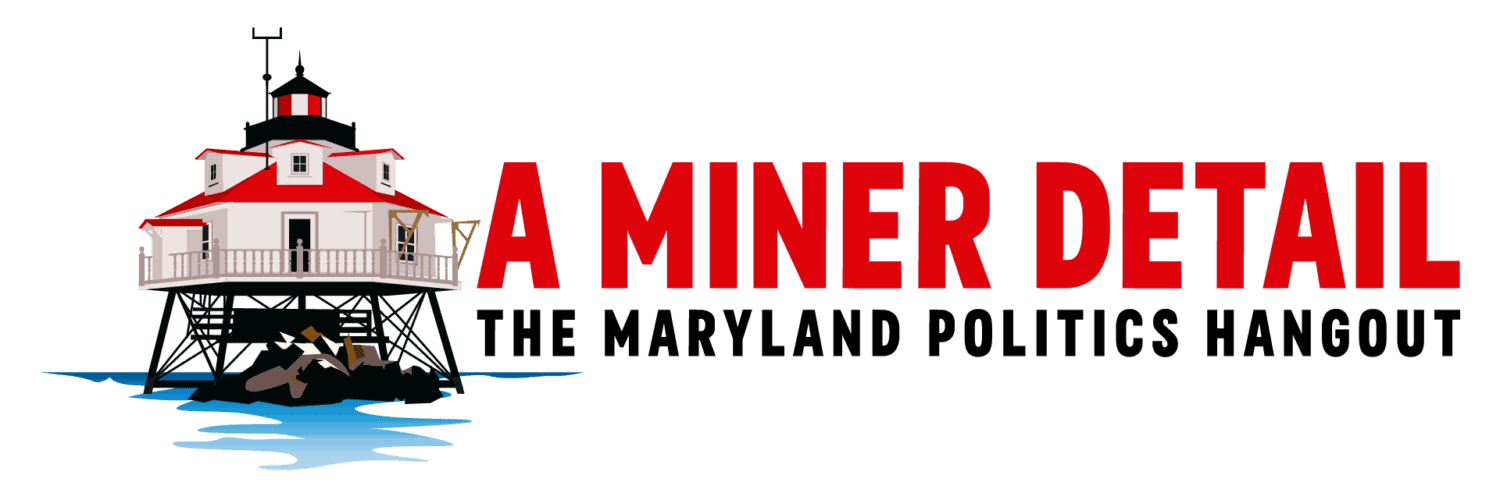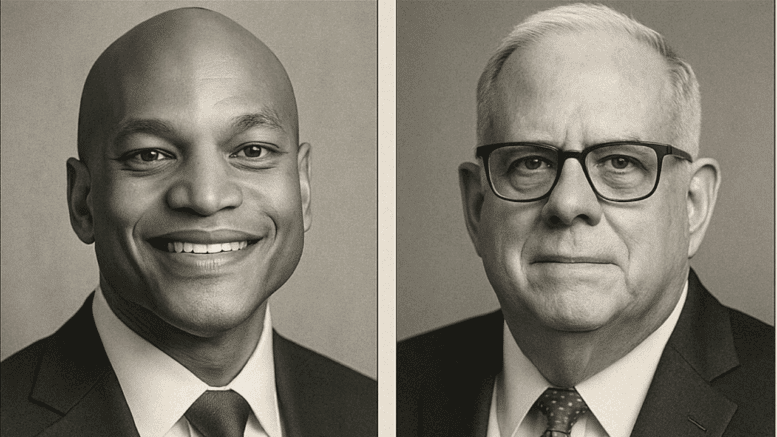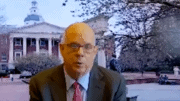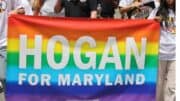Maryland Governor Wes Moore’s job approval rating has slipped to 50%, according to a new Maryland NOW poll released Monday, revealing particular weakness among Democratic voters that could prove problematic if he faces former Republican Gov. Larry Hogan in 2026 — a matchup many political observers consider increasingly likely.
The poll, conducted by Blended Public Affairs, led by Maryland’s longtime Democratic political enforcer, Alex Hughes, and the Perry Jacobson lobbying firm between July 24 and 30, surveyed 1,256 Marylanders through text messages linked to an online survey. The margin of error is 2.7 percentage points.
Most concerning for Moore’s political team: just 68% of Democrats rate his performance as “excellent” or “good,” well below the 80% partisan baseline that political professionals consider essential for incumbent strength.
This erosion within Mr. Moore’s Democratic Party comes at a particularly delicate moment, as Mr. Hogan — who left office in January 2023 after two terms with consistently high approval ratings — remains politically active following his November 2024 loss to Angela Alsobrooks in the U.S. Senate race.
“He’s still at 50% approval, but what you see is some base Democrats are starting to give Democrats negative ratings because they’re just freaked out about the federal government,” said pollster Donna Victoria, Blended’s director of research.
The contrast with Mr. Hogan’s gubernatorial tenure stands out in Maryland political history. The Republican, who served from January 2015 to January 2023, maintained approval ratings above 60% for most of his eight years in office, peaking above 70% as he left office.
He achieved this rare feat in deep-blue Maryland by cultivating an image as a pragmatic problem-solver who avoided partisan battles.
Moore’s current 50% approval after less than two years suggests he lacks the crossover appeal that defined Larry Hogan’s success.
The Hogan Factor
Maryland’s constitution barred Mr. Hogan from seeking a third consecutive term in 2022, but he becomes eligible to run again in 2026.
Despite his 54.64% to 42.84% loss to Alsobrooks — a decisive 11.8 percentage point defeat — Mr. Hogan’s gubernatorial record demonstrates he performs significantly better in state races than federal ones.
The distinction matters.
Maryland voters have consistently shown different voting patterns between federal and state elections. Voters who reflexively support Democrats for Congress and Senate have proven willing to split tickets for governor, as Mr. Hogan demonstrated in both 2014 and 2018.
A Moore-Hogan contest would test whether Maryland Democrats, already showing signs of frustration with their governor, would rally behind an incumbent facing a former governor with proven success in gubernatorial races.
The dynamics that powered Mr. Hogan’s previous victories remain present in the current poll data.
Independent and third-party voters are evenly split on Mr. Moore’s performance — 46% approve, 46% disapprove. These swing voters were crucial to Larry Hogan’s gubernatorial wins.
Maryland Republicans, meanwhile, show 84% disapproval of Mr. Moore, matching the typical partisan opposition pattern but also suggesting Mr. Hogan would begin with a solidly unified base.
Maryland Budget Pressures Mount
Gov. Moore’s approval decline from January’s 61% and September 2024’s 64% ratings in Gonzales Research and Media polling coincides with mounting fiscal pressures.
The state faces budget challenges that prompted Mr. Moore to announce a hiring freeze for state workers, extend buyout offers, and promise to eliminate vacant positions — measures that drew only 49% support versus 41% opposition in the poll.
The state budget included both spending cuts and tax and fee increases.
While 66% of those polled support raising state income taxes on those earning more than $500,000 — a component of the latest budget — the mixed reaction to Mr. Moore’s workforce reduction efforts suggests voters remain divided on his fiscal management.
Ms. Victoria attributed some of Mr. Moore’s struggles to federal policy impacts, noting Maryland’s unique vulnerability due to its proximity to Washington and high concentration of federal workers. The state faces potential layoffs of federal workers and loss of federal funding under the Trump administration.
“Moore and the legislature are going to have to adjust to federal money not coming in and the federal government not even keeping its promises on past budgets,” Victoria said.
“He’s definitely going to have to adjust.”
Blame Game Dynamics
The latest poll reveals complex dynamics around economic responsibility.
While 64% of respondents say the United States is “going off on the wrong track” and 55% rate Maryland’s economy as poor or “not so good,” most Marylanders point fingers at Washington rather than Annapolis.
When asked who bears responsibility for the economy, 59% blamed “Trump and Republicans in Congress,” while 25% cited Moore and Maryland Democrats.
Mr. Trump holds a 33% approval rating in Maryland, with 64% disapproving. Yet blame attribution rarely translates directly to voting behavior.
Mr. Hogan maintained strong approval ratings during Donald Trump’s first presidency despite similar federal-state tensions, suggesting voters may judge gubernatorial performance independently of their views on Washington.
The broader Democratic brand shows weakness beyond Mr. Moore himself.
Maryland General Assembly Democrats earned just 39% approval, while Republicans received 30% approval. These low legislative ratings suggest systemic dissatisfaction that could complicate Democratic mobilization efforts in 2026.
Governor Celebrity: Wes Moore’s Growing Presidential Ambitions
Mr. Moore, who had a prime-time speaking slot at the 2024 Democratic National Convention and whose frequent appearances on television and radio talk shows have cultivated an image as a rising Democratic star fixated on perfecting his image among national Democrats, is seemingly losing momentum at home.
American celebrities and Democratic money bundlers are fantasizing about Mr. Moore’s presidential ambitions, with many viewing his governorship as a stepping stone to a 2028 White House bid should former Vice President Kamala Harris falter or choose not to run.
Though the timing couldn’t be worse for Mr. Moore, who begins building his 2026 re-election apparatus while managing both a fiscal crisis and a restive Democratic base.
Democrats in Maryland are growing weary of what some privately describe as Mr. Moore’s “celebrity governor” routine. His frequent out-of-state travel for political events and fundraisers has not gone unnoticed in Annapolis, where legislators of both parties have begun questioning whether the governor’s attention has wandered.
Maryland voters have a long memory for politicians who use the State House as a stepping stone.
Just ask former Maryland Governor Martin O’Malley, whose failed presidential ambitions helped usher in the Larry Hogan era.
Mr. Moore may be wise to study that history before his national ambitions cost him the job he already has
Policy Divisions
The latest poll revealed interesting policy dynamics that could shape a potential gubernatorial campaign. Beyond the tax increase support, 57% backed legalizing online gambling in Maryland.
In comparison, 49% supported paying for road projects through private company contracts that would charge tolls — an approach Mr. Hogan championed as governor and one that Wes Moore has virtually ignored.
The near-even split on toll roads suggests Mr. Hogan’s infrastructure approach retains significant support.
Most overwhelmingly, 80% support allowing beer and wine sales in grocery stores, a perennial issue in Maryland politics that crosses party lines.
Looking Ahead
Mr. Moore is set to address the Maryland Association of Counties’ annual conference in Ocean City on Saturday, August 16, facing government officials and politicians at a crucial moment for his governorship. The conference traditionally serves as an essential political gathering where governors can shore up support among local leaders.
The third Maryland NOW poll from Blended and Perry Jacobson arrives as Mr. Moore enters the critical middle period of his term. Historical precedent offers both warning and opportunity — no Maryland governor has won re-election with approval ratings below 55% the year before their campaign.
Wes Moore has time to recover, but the trajectory raises concerns.
The fundamental challenge for Mr. Moore is rebuilding Democratic enthusiasm while maintaining an appeal to the independents necessary for any statewide victory in Maryland.
Democrats hold roughly a 2-to-1 registration advantage, but that dominance depends on unified support when Democrats fracture — as happened in 2014 when Mr. Hogan defeated then-Lt. Gov. Anthony Brown — Republicans can capitalize.
With Moore at 68% approval among Democrats, he sits close to a danger zone where crossover defections could prove costly against a Republican with Hogan’s demonstrated appeal. Mr. Hogan won re-election in 2018 with 55% of the vote, even as Democrats nationally enjoyed a wave election, carrying a majority of Maryland’s counties while Democrat Ben Jealous captured just 43.5%.
For Larry Hogan, the November 2024 Senate loss may have paradoxically strengthened his potential gubernatorial position. The federal race forced him to engage with national partisan dynamics that typically do not apply to Maryland gubernatorial contests. A return to state-focused campaigning could allow him to recapture the above-partisanship image that made him Maryland’s most popular governor in decades.
As Ms. Victoria noted, how Mr. Moore responds to Donald Trump and Washington Republicans will help determine his political future.
But the poll suggests a more fundamental challenge: convincing Maryland Democrats that he deserves their enthusiasm while simultaneously appealing to independents who may already be nostalgic for the Hogan era.
With approval at 50% and trending downward, Mr. Moore enters the pre-election period in a precarious position — still viable but increasingly vulnerable to a challenge from his popular predecessor.





